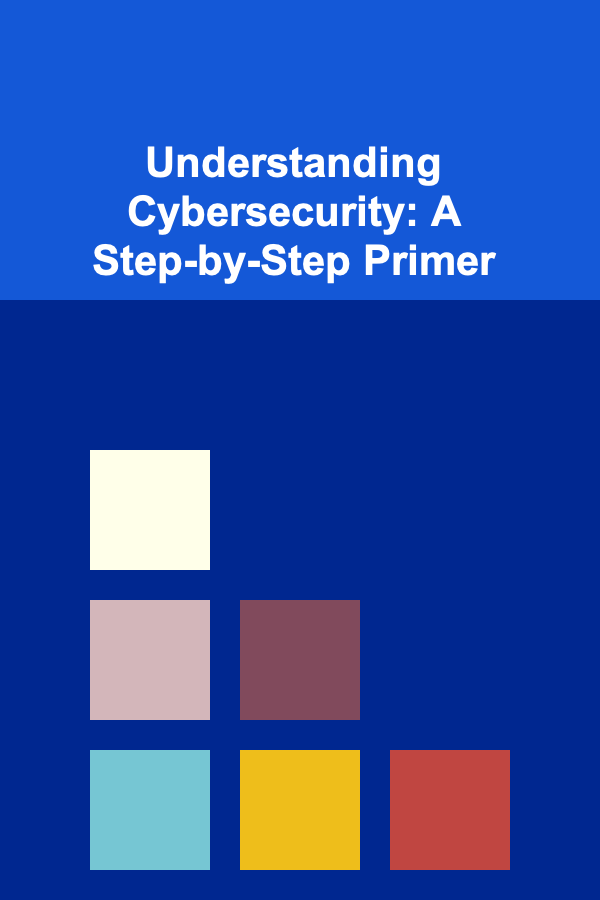
Understanding Cybersecurity: A Step-by-Step Primer
ebook include PDF & Audio bundle (Micro Guide)
$12.99$6.99
Limited Time Offer! Order within the next:

Cybersecurity has become one of the most critical issues of the modern world. As our society grows increasingly dependent on technology, from personal devices to global networks, the importance of safeguarding digital systems, data, and privacy cannot be overstated. Cyberattacks, data breaches, and online threats are a constant concern for individuals, businesses, and governments alike. Yet, many people still struggle to fully comprehend the various facets of cybersecurity, which often leads to poor security practices and vulnerabilities.
This primer is designed to provide a comprehensive understanding of cybersecurity, breaking down its key concepts, components, and strategies. Whether you are a complete beginner or someone looking to expand your knowledge, this guide will walk you through the essential aspects of cybersecurity, equipping you with the information needed to protect your personal and organizational digital assets.
What Is Cybersecurity?
Cybersecurity refers to the practice of protecting systems, networks, and data from digital attacks, theft, or damage. These attacks can originate from a variety of sources, including cybercriminals, hackers, state-sponsored actors, or even malicious insiders within organizations. The goal of cybersecurity is to ensure the confidentiality, integrity, and availability (CIA) of information and to defend against the growing spectrum of cyber threats.
- Confidentiality: Ensuring that information is only accessible to those who are authorized to view it.
- Integrity: Maintaining the accuracy and completeness of data, preventing unauthorized alterations.
- Availability: Ensuring that systems and data are available to authorized users when needed, preventing disruptions.
Cybersecurity involves a range of techniques, policies, and practices designed to guard against cyberattacks and secure sensitive information from compromise. As the digital landscape becomes more complex, cybersecurity continues to evolve, adapting to new threats and technological advancements.
The Importance of Cybersecurity
In today's interconnected world, cybersecurity is no longer optional---it is a necessity. Here's why:
1. The Rising Threat of Cybercrime
Cybercrime is one of the fastest-growing forms of crime worldwide. Hackers and cybercriminals use a variety of tactics, such as phishing, ransomware, and malware, to gain unauthorized access to systems and data. These attacks can lead to financial losses, data breaches, and reputational damage for individuals and organizations alike.
2. Protection of Sensitive Data
Every day, vast amounts of sensitive information are exchanged online, from personal data to financial transactions and trade secrets. Cybersecurity helps protect this data from unauthorized access, ensuring that it remains confidential and secure. Without robust security measures, individuals and businesses risk falling victim to data theft and exploitation.
3. Safeguarding Critical Infrastructure
Critical infrastructure, such as power grids, water supplies, and healthcare systems, relies heavily on digital networks and technologies. A successful cyberattack on these systems could cause significant harm to public safety and national security. Ensuring that these systems are secure is paramount to maintaining the functioning of modern society.
4. Preventing Financial Losses
The financial cost of cyberattacks can be staggering. In addition to direct losses from theft, organizations may incur costs related to recovery efforts, legal fees, and regulatory fines. Effective cybersecurity practices help mitigate these risks and reduce the likelihood of costly incidents.
5. Maintaining Trust and Reputation
For businesses, maintaining a good reputation is crucial to customer trust and retention. A single data breach or cyberattack can severely damage a company's credibility and lead to loss of clients and customers. Cybersecurity is essential for maintaining this trust by ensuring that customer data and business operations are protected.
Key Components of Cybersecurity
Cybersecurity is a broad and complex field, consisting of various components that work together to safeguard digital assets. Below are the key areas that form the foundation of effective cybersecurity:
1. Network Security
Network security involves securing the infrastructure of a computer network to prevent unauthorized access, data breaches, and other cyber threats. Key practices within network security include:
- Firewalls: Act as barriers between a trusted network and an untrusted network, filtering traffic to prevent malicious access.
- Intrusion Detection and Prevention Systems (IDPS): Monitor network traffic for signs of malicious activity and respond to prevent attacks.
- Virtual Private Networks (VPNs): Encrypt internet traffic to ensure privacy and security, especially when using public networks.
2. Information Security
Information security focuses on protecting the integrity, confidentiality, and availability of data, both in transit and at rest. This involves implementing encryption, access control, and data classification systems to safeguard sensitive information from unauthorized access or tampering.
- Encryption: Converts data into an unreadable format to protect it from unauthorized access. Only those with the decryption key can read the data.
- Access Control: Ensures that only authorized users can access specific data and systems, limiting potential exposure to security breaches.
- Data Classification: Categorizes data based on its sensitivity to apply appropriate security measures to each type of information.
3. Application Security
Application security focuses on securing software applications and their underlying systems from vulnerabilities and threats. This involves practices such as:
- Code Analysis: Reviewing application code for potential security vulnerabilities before deployment.
- Patch Management: Regularly updating applications and systems to fix known security flaws.
- Authentication: Implementing strong authentication mechanisms to ensure that only authorized users can access the application.
4. Endpoint Security
Endpoint security involves securing devices such as computers, smartphones, and tablets that connect to a network. These devices are often the primary targets for cyberattacks, as they can serve as entry points into larger networks. Endpoint security strategies include:
- Antivirus and Antimalware Software: Protect devices from viruses, malware, and other harmful software.
- Device Encryption: Protects the data on devices by making it unreadable to unauthorized individuals.
- Mobile Device Management (MDM): Allows businesses to manage and secure mobile devices used by employees, ensuring they comply with company security policies.
5. Identity and Access Management (IAM)
IAM is a framework for managing the identities and access privileges of users within an organization. It involves ensuring that only authorized individuals can access specific systems, applications, or data. Key components of IAM include:
- Authentication: Verifying the identity of a user, often through passwords, biometrics, or multi-factor authentication.
- Authorization: Determining what level of access a user has based on their role or permissions.
- Single Sign-On (SSO): Allows users to access multiple systems with one set of login credentials, simplifying access while maintaining security.
6. Cloud Security
As more organizations move their data and applications to the cloud, cloud security has become a critical area of focus. Cloud security involves securing cloud-based systems, applications, and data from potential threats. This includes practices such as:
- Data Encryption: Protecting data stored in the cloud by encrypting it both during transfer and at rest.
- Access Controls: Ensuring that only authorized users can access cloud-based resources.
- Cloud Security Posture Management (CSPM): Tools that help organizations manage and monitor the security configurations of their cloud infrastructure.
7. Disaster Recovery and Business Continuity
Disaster recovery (DR) and business continuity (BC) are strategies that ensure an organization can continue operating in the event of a cyberattack or other disaster. DR involves restoring data and systems after an attack, while BC focuses on maintaining essential operations during and after an incident. Key components of DR and BC include:
- Backup Systems: Regularly backing up critical data to ensure it can be restored in case of a disaster.
- Incident Response Plans: Predefined strategies for responding to cybersecurity incidents to minimize damage and recover quickly.
- Redundancy: Implementing backup systems, servers, and infrastructure to ensure continuity of services if primary systems fail.
Common Cybersecurity Threats
Cybersecurity threats come in many forms, each with its own tactics and targets. Some of the most common threats include:
1. Phishing Attacks
Phishing involves tricking individuals into revealing sensitive information, such as login credentials or financial details, by pretending to be a trustworthy entity. This is often done via email, text messages, or fake websites designed to mimic legitimate organizations.
2. Malware
Malware refers to malicious software that is designed to disrupt, damage, or gain unauthorized access to systems. Common types of malware include:
- Viruses: Self-replicating programs that can spread through files and networks.
- Ransomware: A type of malware that encrypts files and demands a ransom for decryption.
- Spyware: Software designed to monitor and collect data from a system without the user's knowledge.
3. Denial of Service (DoS) Attacks
A DoS attack aims to make a system or network unavailable to its intended users by overwhelming it with a flood of traffic or other disruptive activities. This can cause significant downtime and disrupt business operations.
4. Insider Threats
Insider threats occur when individuals within an organization, such as employees or contractors, intentionally or unintentionally compromise the security of systems or data. These threats can be difficult to detect and may involve stealing data, mishandling sensitive information, or unintentionally opening the door to external attackers.
5. Man-in-the-Middle (MitM) Attacks
A MitM attack occurs when an attacker intercepts and potentially alters communication between two parties without their knowledge. This can lead to data breaches, loss of confidentiality, or tampering with critical information.
Best Practices for Enhancing Cybersecurity
To mitigate the risk of cyber threats and ensure robust protection of digital assets, individuals and organizations should adopt the following best practices:
- Use Strong, Unique Passwords: Avoid using common or easily guessable passwords. Use complex, unique passwords for each account, and consider using a password manager to keep track of them.
- Enable Multi-Factor Authentication (MFA): MFA adds an extra layer of security by requiring users to provide two or more forms of verification before granting access to accounts or systems.
- Keep Software Updated: Regularly update operating systems, applications, and antivirus software to ensure they are protected against known vulnerabilities.
- Educate Users: Train employees or family members on recognizing phishing attempts and avoiding risky online behavior.
- Backup Data: Regularly back up important data to ensure it can be recovered in the event of a cyberattack or hardware failure.
- Implement Firewalls and Intrusion Detection Systems: Use firewalls to filter traffic and intrusion detection systems to monitor for suspicious activity.
Conclusion
Cybersecurity is an essential field in today's digital world, and understanding its principles and practices is crucial for protecting personal and organizational assets. By grasping key concepts such as network security, information protection, and common cyber threats, individuals and businesses can take proactive steps to defend against the ever-growing landscape of cybercrime. Whether you are an individual looking to protect your personal data or a business striving to secure your infrastructure, cybersecurity is an ongoing process that requires diligence, knowledge, and constant adaptation to new challenges.

How to Document Changes in Your Wellness Space Over Time
Read More
How to Organize Spices for Quick Ingredient Retrieval
Read More
Why Utilizing Vertical Gardens Can Organize Outdoor Spaces
Read More
How to Develop a Workout Routine for Busy Parents
Read More
Legally Minimizing Taxes for More Profit: A Comprehensive Guide
Read More
How to Pack a First-Aid Kit for International Travel
Read MoreOther Products

How to Document Changes in Your Wellness Space Over Time
Read More
How to Organize Spices for Quick Ingredient Retrieval
Read More
Why Utilizing Vertical Gardens Can Organize Outdoor Spaces
Read More
How to Develop a Workout Routine for Busy Parents
Read More
Legally Minimizing Taxes for More Profit: A Comprehensive Guide
Read More